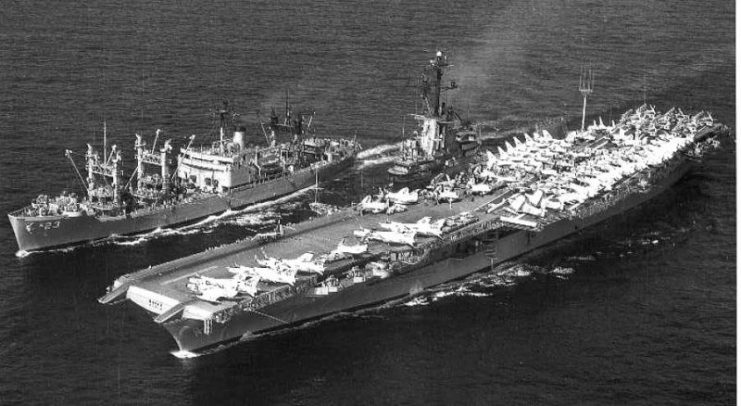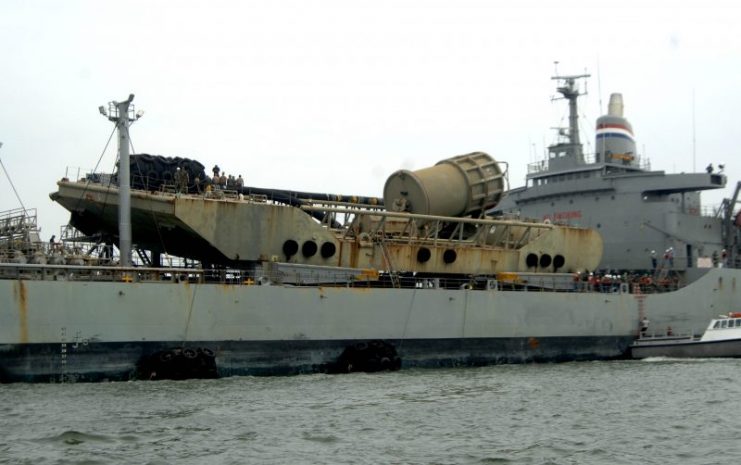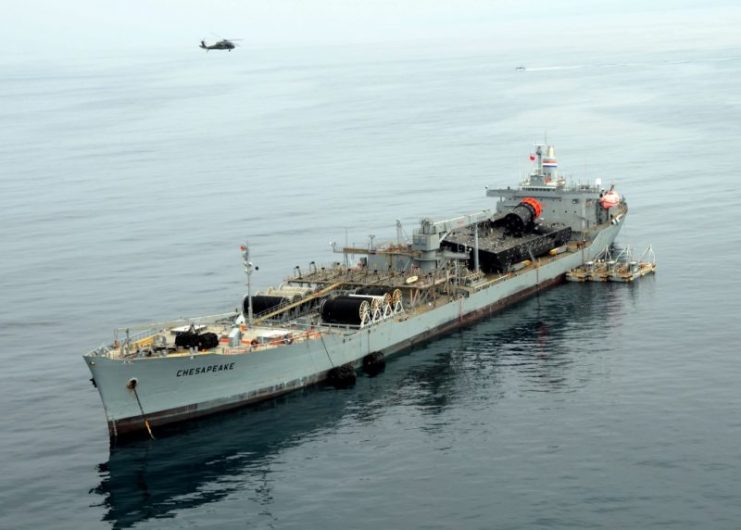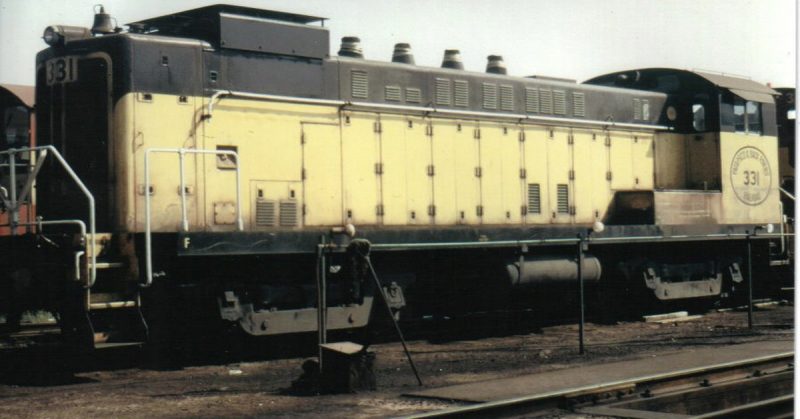War History Online Presents this Guest Blog From Tyler Turpin
Canton Railroad locomotive #32 has touched national and world history from 1944 to the present. A 48 foot long 120 ton Baldwin VO 1000 diesel road switcher built in 1944 spent its whole service life of 40 years in Baltimore City and County of Maryland before entering the collection of the B and O Museum in the City of Baltimore. It is one of the few built by Baldwin Locomotive Works of Eddystone, PA diesel locomotives to be preserved with a Baldwin built main motor still in it.
A road switcher is a type of railroad locomotive used for delivering or picking up cars outside of a railroad yard and able to be used for yard switching and mainline freight duties. The Canton No. 32, a Baldwin VO-1000 with builder #70132 was built for the Canton Railroad of Baltimore, Maryland in January 1944 as the No. 30. In 1953, the No. 30 was sold to the Patapsco and Back Rivers Railroad (P&BR) and renumbered as the No. 331. The P&BR rebuilt the No. 331 with an 8 cylinder Baldwin prime-mover in 1955. The No. 331 was sold back to the Canton Railroad and the railroad renumbered it as the No. 32. By the 1980s, the No. 32 was placed in storage. In 1992, the No. 32 was sold to Striegel Equipment Company and then to the Baltimore & Ohio Railroad Museum.
The Canton Railroad, since its founding in 1906, has been a short line railroad connecting industrial and maritime industry operations of the Canton section of Baltimore to the large railroads. Prior to, during, and after World War II there was a Lever Brothers, later Unilever, soap and glycerin factory in Canton that all branches of the Armed Forces and its contractors used products from. Canton Corporation piers 10 and 11 were an Army Transportation Corps operated cargo port facility in the World War II era.Fort Holabird was, in World War II, a major US Army vehicle design, test, maintenance, and modification center.. American Smelting and Refining and Revere Copper and Brass and predecessors both had copper processing plants in the area from the 19th century until the mid-1970s.
While in use at Sparrows Point, from 1953 to the mid-1970s, the locomotive transported materials and components for the construction of several auxiliary ships and some privately owned merchant vessels that were later acquired by the Navy or Maritime Administration for use or as mobilization assets. One ship built at the yard was the USS Nitro (AE 23) which was part of the first five US Navy ships designed as ammunition ships. The ship was laid down by Bethlehem Steel Corporation’s Sparrows Point Shipyard, Baltimore Md., May 20, 1957 and commissioned May 1, 1959.

During the period from 11 to 24 November 1961, Nitro sailed to the Caribbean in support of the Task Force engaged in the quarantine of Cuba. From May of 72 to February of 73 the ship was deployed in the Vietnam War zone supplying 6 and 8-inch shells to the remaining gun cruisers of the Navy and five-inch shells to cruisers and destroyers. In December 1983 the Nitro delivered powder and shells to the USS New Jersey via underway replenishment for the battleship to provide shore bombardment in support of US forces in Lebanon. In 1985 the Nitro was part of the Navy ships on alert in the eastern Mediterranean Sea in response to the June 14 to June 30, 1985, hijacking of TWA Flight 847. In January 1991, the Nitro deployed to Operation Desert Shield/ Desert Storm and supplied 13 million pounds of ammunition including shells for the battleships USS Missouri and Wisconsin. The USS Nitro was decommissioned in 1995 and scrapped in 2008.

The tanker Chesapeake was built in 1964 as the Hess Voyager for the Hess Oil & Chemical Corporation at Bethlehem Steel’s Sparrows Point Shipyard in Baltimore. Its intended use was for the transport of crude oil and refined petroleum products between the company’s refineries and terminals along the U.S. Gulf and East coasts. After a number of years in service, the ship was sold to Keystone Shipping, which renamed it Chesapeake in 1980. In December 1987, Keystone transferred the ship to the Maritime Administration under the latter’s Ship Exchange Program for use by the Military Sealift Command (MSC). In 1989, the ship was equipped with the Navy’s Offshore Petroleum Discharge System, a means of offloading cargo in areas without port facilities. This system comprised on-deck reels for flexible conduit, new high-pressure cargo pumps, gantries and cranes for stowing and launching the system’s submersible mooring platform, buoys, portable shore terminals, and support boats.
The Chesapeake was assigned to MSC’s Ready Reserve Force where it was maintained ready for rapid activation when needed to support Department of Defense activities. Its first major deployment in this role was in the Persian Gulf during the first Gulf War. From 2001 to 2006, the Chesapeake supported U.S. forces in the Persian Gulf and the Indian and Pacific oceans through a long-term deployment to the prepositioning force based at the remote island of Diego Garcia.

US Navy photo # 080722-N-1424C-538 PACIFIC OCEAN (July 22, 2008) by MC2 Brian P. Caracci.
The 494 foot Cape Chalmers ex Adabelle Lykes was acquired by MARAD on November 6, 1984, and assigned to the James River Reserve Fleet. On April 8, 2005, it was towed to the Federal Law Enforcement Training Ctr. in Charleston, SC on loan by MARAD to the Dept. of Homeland Security operated center that specializes in maritime and advanced training for various agencies. Charleston serves as the center of training for the U.S. Coast Guard’s Maritime Law Enforcement Academy. A signature component of the Charleston complex is the assortment of boat boarding platforms and shipboard training venues, to include the SS Cape Chalmers.
Operation and maintenance expenses of material handling equipment, including their operating staff, are part of overhead expenses factored into the cost of every contract for manufactured /processed goods with a customer. Overhead costs are indirect costs that support a production function. VADM Oscar C. Badger, USN said in a 1951 Navy publication “Logistic considerations belong not only in the highest echelons of military planning during the process of preparation for war and for specific wartime operations, but may well become the controlling element with relation to timing and successful operation.”
The history of Canton Railroad locomotive 32 is a legacy of its wheels having an impact from cargo carried by the Red Ball Express in France, copper driving bands of artillery shells that held the Pusan perimeter, the naval bombardments in the Cua Viet River region of Vietnam, fuel and lubricants pumped ashore in Desert Storm and Iraqi Freedom, to the latest USCG Maritime Enforcement Specialist “A” school students learning their specialist skills. Canton 32 made a contribution, to the military and commercial history of America and is woven into the fabric of this nation and its place in the world.
History of the locomotive is from the B & O Museum of Baltimore, details of industrial sites of Canton area of Baltimore are from NPS documents and historic Canton by Norman G. Rukert.
